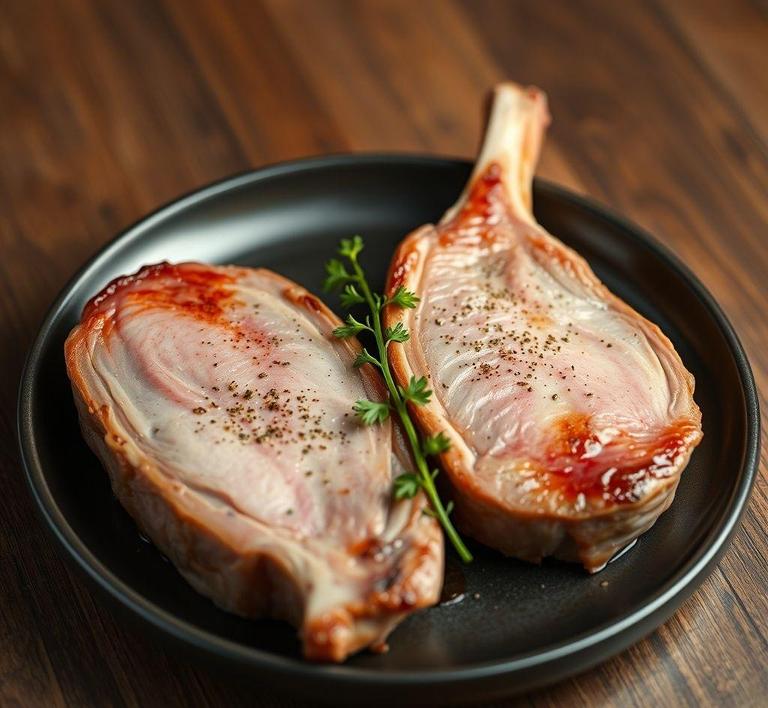If you’ve ever wondered whether it’s safe to refreeze pork chops, you’re not alone! Many people find themselves in situations where they’ve thawed more pork chops than they can use right away. The good news is, you can refreeze pork chops, but there are a few important things to keep in mind to ensure they’re safe to eat and still taste delicious. In this guide, we’ll walk you through the process of how to properly refreeze pork chops, tips for preserving their quality, and some helpful food safety advice to avoid any unwanted surprises in your next meal. Let’s dive in!
Can You Refreeze Pork Chops?

Refreezing pork chops-or any meat for that matter-can be a topic of much debate, with concerns ranging from food safety to quality preservation. The general rule is yes, you can refreeze pork chops, but with certain caveats. It’s essential to consider how the pork chops were thawed initially, the duration they’ve been at room temperature, and whether they’ve been properly handled throughout the process.
Food Safety Concerns
The USDA advises that as long as pork chops (or any meat) have been thawed in the refrigerator and haven’t been left out for extended periods, they can be refrozen. The key here is that the pork chops must have been thawed safely-preferably in the fridge, not on the counter. If thawed in the refrigerator, refreezing won’t introduce harmful bacteria, as long as the meat didn’t stay in the "danger zone" (temperatures between 40°F and 140°F) for more than two hours. If the pork chops have been left out too long or thawed in warm conditions, refreezing could allow harmful bacteria to multiply, which makes it unsafe.
Initial Freezing Process
If the pork chops were frozen directly from fresh (without being thawed and refrozen multiple times), they retain better overall quality when frozen. The key is to ensure that they were frozen quickly and securely to maintain freshness. The best practice is to freeze the pork chops in air-tight packaging to avoid freezer burn, which can also negatively affect the texture and flavor of the meat.
How To Refreeze Pork Chops?
Refreezing pork chops requires careful attention to detail to ensure they remain safe to eat and retain their quality. Here’s a step-by-step guide on how to properly refreeze them:
-
Thawing Process:
Before refreezing, it’s important that the pork chops were thawed correctly. They should be defrosted in the fridge, not on the counter. This allows them to remain at a safe temperature. It’s also crucial to ensure the pork chops are not left in the fridge for more than 3-4 days before you attempt to refreeze them.
-
Inspect for Quality:
Check the pork chops for any signs of spoilage before refreezing. If they appear slimy, have an off smell, or exhibit any discoloration (like green or brown spots), discard them, as these could be indications of bacterial growth. Only proceed with the refreezing process if they appear fresh and there’s no evidence of deterioration.
-
Proper Packaging:
To refreeze pork chops successfully, it’s essential to ensure they are packaged properly. Use a vacuum-sealed bag or tightly wrap the chops in plastic wrap followed by aluminum foil, or place them in a freezer-safe ziplock bag. Expelling as much air as possible prevents freezer burn and preserves the quality of the meat. Freezer burn happens when air is allowed to come into contact with the pork chops, causing them to dry out and lose flavor. Proper packaging helps protect the meat from this and locks in moisture.
-
Labeling and Storing:
Label the packaging with the date and type of meat to keep track of how long the pork chops have been stored. Pork chops can be refrozen up to 3-4 months after the initial freezing, though their quality is best maintained within the first couple of months. When storing, place the pork chops in the coldest part of the freezer to ensure they freeze quickly and consistently.
-
Thawing Again:
When you’re ready to use the refrozen pork chops, thaw them again in the refrigerator, never on the counter. This ensures that they stay within a safe temperature range and reduces the risk of foodborne illness.
Quality Impact
Refreezing pork chops, while generally safe if done correctly, does have an impact on their overall quality. The changes typically occur in the texture, flavor, and moisture content of the meat.
Texture
When pork chops are frozen and thawed multiple times, the muscle fibers in the meat can become damaged, leading to a loss of their firm, tender texture. This is because the freezing process causes water in the meat cells to expand into ice crystals. When these ice crystals form, they rupture the cell walls, which results in the meat losing some of its natural moisture. When refrozen, the texture of the pork chops can become increasingly dry and tougher once cooked. The best way to avoid this is by making sure they’re cooked soon after defrosting, not letting them sit around long enough for the quality to degrade.
Flavor
Pork chops that are refrozen multiple times may also lose some of their flavor. This is due to moisture loss during the freezing and thawing process, which causes the meat to taste less juicy and flavorful. Freezer burn, which happens when meat is exposed to air in the freezer, is another culprit for flavor loss. While the pork chops may still be safe to eat after refreezing, the flavor will likely not be as rich as freshly frozen or fresh pork chops.
Moisture Loss
One of the most significant impacts of refreezing pork chops is moisture loss. As previously mentioned, the formation of ice crystals during the freezing process damages the cellular structure of the meat. When you thaw and cook the pork chops, some of this moisture is lost, leaving the chops less juicy. This is particularly noticeable in thicker cuts of meat.
While refreezing pork chops is safe as long as they’ve been handled properly throughout the thawing and freezing process, it’s important to consider both the food safety and quality factors. Proper thawing and refreezing techniques can help preserve the meat’s edibility, but there will be some trade-offs in terms of texture, flavor, and moisture retention.
For the best results, it’s recommended to only refreeze pork chops once and to always ensure they are stored in the coldest part of the freezer with airtight packaging to prevent freezer burn. Keep in mind that while refreezing is safe in most circumstances, the quality may not be as high as it was before freezing, especially if the pork chops have been frozen and thawed multiple times. Always make sure that you’re working with meat that looks, smells, and feels fresh to ensure a safe and enjoyable eating experience.
Is It Safe To Refreeze Pork Chops?
The safety of refreezing pork chops, or any meat for that matter, hinges on several important factors: temperature, time, and the condition of the meat. In general, the answer is both yes and no-it can be safe to refreeze pork chops, but only under specific conditions.
When pork chops are thawed, the quality of the meat can be affected, especially if they were not handled correctly. The USDA advises that meat can be refrozen if it has been thawed in the refrigerator, as long as it has not been left at room temperature for more than two hours. If the pork chops were thawed in the microwave or via cold water, refreezing is not recommended unless they were cooked right after thawing. The primary concern when refreezing raw pork is the potential for bacteria growth, which accelerates as the meat sits at room temperature for too long.
It’s also crucial to consider the initial quality of the pork chops. If they were already of questionable quality before freezing-such as being close to their expiration date-refreezing them could lead to an even worse texture and taste when you finally do cook them. While refreezing might technically be safe, it can have a profound impact on the overall flavor, texture, and juiciness of the pork chops.
Signs That Pork Chops Should Not Be Refrozen
Knowing when to avoid refreezing pork chops is just as important as understanding when it’s safe to do so. There are several red flags you can look for to ensure the pork chops haven’t gone bad, and these signs will prevent you from risking food safety or ruining a meal.
- Excessive Freezer Burn: Freezer burn occurs when meat is exposed to air in the freezer, causing it to dry out and develop off flavors. If your pork chops have large, white, leathery patches, it’s a sign of freezer burn. Although freezer-burned meat isn’t harmful to consume, it will likely be tough, dry, and flavorless. Refreezing pork chops with these patches can further deteriorate the meat’s quality.
- Off Smell: Fresh pork chops should have a mild, meaty scent. If they emit a sour or rancid smell after being thawed, this is a clear indication that bacteria or spoilage has set in. Once meat reaches this point, it’s best to discard it. Refreezing would only lock in the spoilage, making the meat unsafe to eat later.
- Change in Color: While slight discoloration in frozen pork chops is normal, any drastic change in color-such as grayish or greenish hues-can be a warning sign that the meat has been thawed and stored improperly, or that it has gone bad. A fresh, high-quality pork chop should have a pinkish-red color. If the meat looks dull or has spots of discoloration, avoid refreezing it.
- Slimy Texture: If your thawed pork chops have become slimy to the touch, it’s a sign of bacterial growth. This sliminess indicates that the pork chops have been sitting too long in the danger zone (40°F to 140°F) for bacterial proliferation. Refreezing pork chops with a slimy surface will not make them safe to eat; instead, discard them immediately.
Common Refreezing Mistakes
While it’s possible to refreeze pork chops safely, people often make mistakes that compromise both the safety and quality of the meat. Avoiding these common pitfalls can ensure that your pork chops maintain their flavor and safety when frozen and thawed multiple times.
- Thawing at Room Temperature: The worst mistake you can make when thawing pork chops is to leave them at room temperature. This allows bacteria to multiply rapidly on the surface of the meat, which significantly increases the risk of foodborne illness. Always thaw meat in the fridge, which keeps it at a safe temperature of 40°F or lower.
- Refreezing Without Cooking: Refreezing raw pork chops after they have been thawed-especially if they were thawed in the microwave or using the cold water method-can result in bacterial growth. If you want to refreeze pork chops that have been thawed, cook them first. This kills bacteria and makes the meat safe to freeze and store again.
- Refreezing Multiple Times: The more times you freeze and thaw meat, the worse its texture and taste will become. The meat’s cellular structure breaks down each time it undergoes a freezing-thawing cycle, leading to loss of moisture and a mushy texture. Try to limit the number of times you refreeze pork chops to avoid compromising their integrity.
- Not Sealing Properly: One of the most common mistakes when freezing pork chops is improper sealing. If the chops are not sealed airtight, moisture can escape and cause freezer burn. Always use high-quality freezer bags, plastic wrap, or vacuum-seal containers to prevent exposure to air. This helps maintain the texture and flavor during storage.
Tips And Tricks
- Proper Packaging: If you plan on freezing pork chops, packaging them properly is crucial. Use vacuum-seal bags or tightly wrap each chop in plastic wrap, followed by aluminum foil. This double-layer method ensures that the meat stays protected from freezer burn and retains its flavor.
- Label and Date: To avoid confusion, always label your frozen pork chops with the date they were stored. This helps keep track of how long they’ve been frozen. Generally, pork chops should be consumed within 4-6 months for optimal quality, though they will remain safe to eat indefinitely if kept at a consistent freezing temperature.
- Freeze in Portions: Instead of freezing large quantities of pork chops all together, it’s a good idea to freeze them in individual or meal-sized portions. This way, you can defrost just what you need, preventing the need to refreeze any remaining portions.
- Defrost Gradually: If you’re planning to cook your refrozen pork chops, it’s important to defrost them slowly. Place them in the refrigerator for 24-48 hours before cooking. This ensures the meat thaws evenly and reduces the risk of bacterial growth.
- Cook Before Refreezing: If you’re unsure whether you’ll use the pork chops in time, consider cooking them first before refreezing. Cooked pork can be refrozen safely for up to 2-3 months and will generally maintain better quality and texture than if it were raw.
Conclusion
In conclusion, while refreezing pork chops is technically safe, it comes with a set of important caveats to ensure both safety and quality. When done correctly, refreezing can be an effective way to extend the shelf life of your pork chops, but improper handling or refreezing multiple times can lead to food safety issues or a poor eating experience.
The key is to ensure that pork chops are thawed properly (preferably in the refrigerator), cooked if necessary, and sealed carefully to avoid freezer burn. By adhering to safe thawing practices, paying attention to signs of spoilage, and avoiding common mistakes, you can enjoy delicious and safe refrozen pork chops.
Ultimately, when in doubt, cook the pork chops and refreeze the cooked meat instead of refreezing them raw. This guarantees both safety and quality, ensuring your meal is both tasty and free from foodborne risks.


